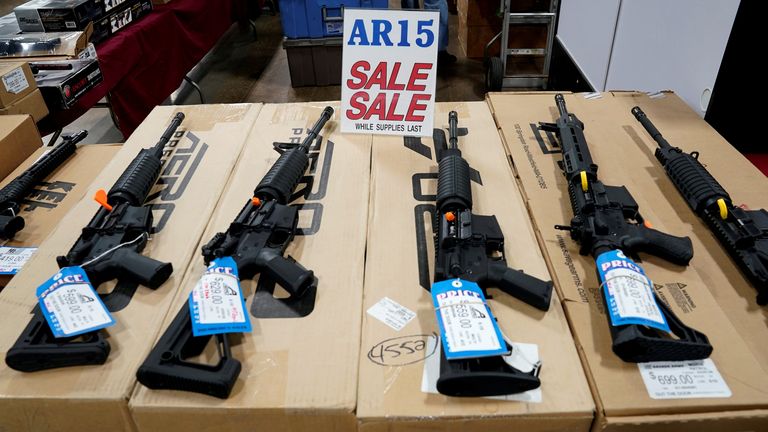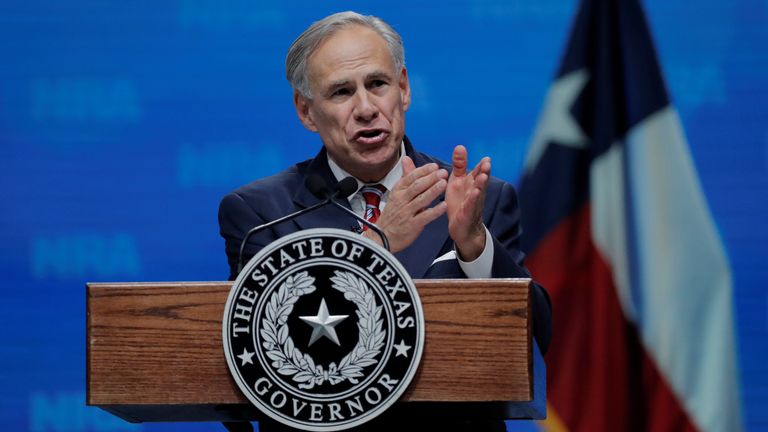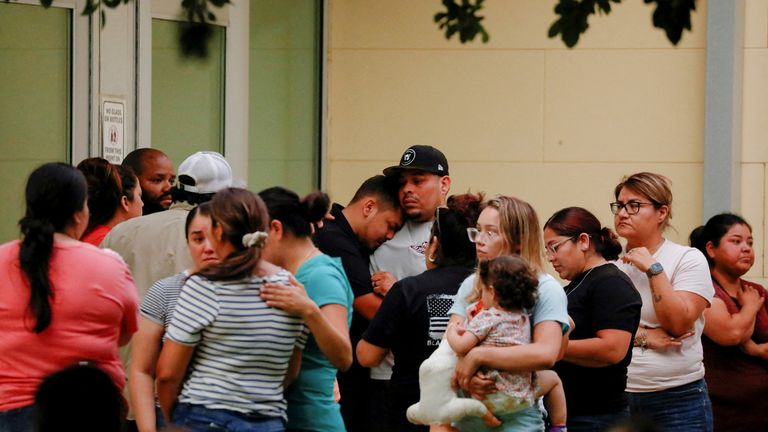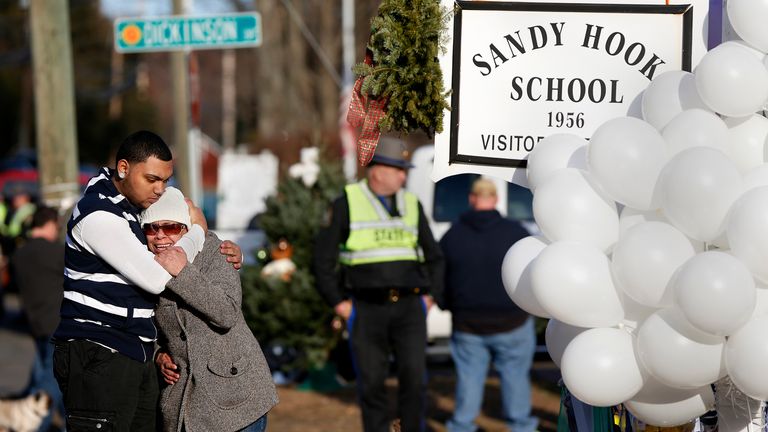[ad_1]
The fatal shooting of 19 children and two adults at a primary school in Texas has renewed calls for a crackdown on gun ownership in the US and the reform of the country’s gun laws.
The attack in the city of Uvalde is the deadliest school shooting in the US since the Sandy Hook massacre in Connecticut in 2012, when a gunman killed 20 six and seven-year-olds and six members of staff before turning the gun on himself.
Since then, there have been a further 3,500 mass shootings across the US.
Joe Biden, the vice-president at the time, was tasked with strengthening gun laws in the months and years that followed, but several attempts have been blocked by Republican senators and gun lobbyists.
New images of the killer and his guns emerge – follow live updates
Here Sky News takes a closer look at how US gun laws work and why they are so hard to change.
Federal laws and the Second Amendment
The right to bear arms is enshrined in the US Constitution under the Second Amendment.
This means that alongside the right to free speech and practising religion, having a gun is a fundamental right for Americans.
As a result, around a third of American adults own a gun, research by the Pew Research Center showed in June last year.
Forty per cent say they live in a household with a gun, its survey found.
Federal laws on guns, which apply to all states, are largely covered by 11 pieces of legislation.
They establish a basic national criteria for issuing gun licences, but there are considerable loopholes.
Individual states have their own laws, which, depending on their political leaning, bolster or loosen federal requirements.
Largely gun laws are dictated at state level due to the filibuster mechanism in the Senate, where laws are passed, which allows the minority party (currently the Republicans) to debate laws indefinitely and therefore stop them being passed.
Who isn’t allowed a gun?
Under the federal Gun Control Act of 1968, people are not allowed to have a gun licence if they are:
- Under the age of 18 for rifles and 21 for all other guns
- A fugitive
- An unlawful user or someone who is addicted to a controlled substance (including marijuana users in states where it is legal)
- Unlawfully in the US or in the US under a non-immigrant visa
- Have been dishonourably charged from the US Armed Forces
- Have been involuntarily hospitalised or committed to a mental health or substance abuse treatment facility by a court
- Have been convicted or indicted of a federal crime with a prison sentence of more than a year
- Have been convicted or indicted of a state crime (that isn’t a misdemeanour) with a prison sentence of more than a year
- Have been convicted or indicted of a state crime considered a misdemeanour with a prison sentence of more than two years
- Have been convicted of a misdemeanour domestic violence offence
- Have been found by a court to be a danger to themselves or others or lack the mental capacity to manage their own affairs
- Subject to a court restraining order for harassing, stalking, or threatening an intimate partner, child, or child of their partner
To establish someone’s eligibility for a gun licence, the seller is supposed to carry out background checks.
Background checks were expanded in 2012 by a change to FBI databases which mean they now include people banned from having guns under state law as well as federal law.
However, guns are increasingly being sold unregulated and without background checks over the internet and by unlicensed sellers, creating a major loophole.
There are also different rules for different types of weapons.
Generally automatic weapons are subject to greater restrictions, with semi-automatic and non-automatic firearms largely legal outside state laws restricting them.
Some states also ban “high capacity” gun magazines, a type of storage device.
How do state laws differ?
All states apart from Vermont have their own laws that ban people from having guns if they have been convicted of a crime punishable by more than a year in prison.
In Vermont this only applies to “violent crimes”, such as murder, assault, domestic violence and stalking.
In California, Colorado and Connecticut, people are banned from having guns if they have committed various smaller misdemeanours, including ones involving violence, firearm use and hate crimes.
New Jersey state law is stricter than federal law, prohibiting gun licences for people convicted of any offences with sentences of more than six months.
Illinois state law prevents people from having guns if they have been convicted of a felony or misdemeanour for certain violent offences within the past five years.
Some states also enforce specific gun restrictions on people convicted of stalking offences, those grappling with substance abuse or mental health issues.
Texas
Texas, which is overwhelmingly Republican, has recently passed several laws making it easier for people to access guns.
On 1 September last year, a “constitutional carry” law came into effect, which means Texans over 21 no longer need a licence to carry a handgun in public.
Laws were also passed to allow hotel guests to have firearms in their rooms and gun owners to carry weapons in their holster of choice.
Greg Abbott, the state’s Republican governor, also passed a law that made Texas a “Second Amendment Sanctuary State”, guaranteeing protections against any new federal gun regulations.
Red flag laws
Some states have their own laws that enable courts to confiscate arms from people considered to be a danger to themselves or other people.
They are known as “red flag laws” as requests for such “extreme risk protection orders” often come from friends or relatives who have expressed concern about the person’s behaviour. Local authorities are also able to apply for them.
Currently 19 states and Washington DC have their own red flag laws in place.
Notably, Texas, where the school shooting happened on Tuesday, does not have one.
The first was passed in Connecticut after Michael Beck, an accountant who had shown signs of stress and mental health problems, shot and stabbed four of his colleagues in 1998.
National red flag bills have come before Congress but repeatedly failed.
Why is restricting guns in the US so difficult?
With its long-standing constitutional right to bear arms, reducing access and the number of guns in the US has always appeared near-impossible.
Powerful pro-gun groups, namely the National Rifle Association (NRA), have been active since the beginning of the 20th century.
The NRA spends around $3m (£2.4m) a year lobbying politicians to vote in favour of protecting gun rights.
Republican congressmen are given thousands of dollars towards their campaigns in exchange for voting against any new restrictions.
Among those who have benefited the most are Texas’s Ted Cruz and Florida’s Marco Rubio.
With Republicans traditionally holding pro-gun attitudes, it has been largely down to Democrat administrations to try to change federal gun laws.
As a senator for Delaware in 1994, Mr Biden helped Bill Clinton pass a ban on assault weapons, but this only lasted for 10 years.
As vice-president to Barack Obama, Mr Biden orchestrated 23 executive actions on gun violence after the Sandy Hook shooting.
Ultimately, in 2013, a bill that would have significantly expanded background checks was defeated in the Senate.
Read more:
What do we know about the Texas school shooting so far?
Frantic parents tell of waiting on news after 19 children killed
Biden – Why do we keep letting this happen?
In the aftermath of a shooting in 2018 at Stoneman Douglas High School in Florida that killed 17 people, President Donald Trump stunned his fellow Republicans by going against the NRA and calling for “comprehensive” new legislation on guns.
He warned other members of his party not to be “petrified” of lobbyists and that something had to be done.
Ultimately, however, despite a ban on devices called bump stocks that help aim semiautomatic rifles, no federal changes were made.
Since entering the Oval Office, President Biden has not yet had any success in changing gun laws, despite proposing four packages of executive actions.
In an address on Tuesday after the shooting in Texas, he said: “When in God’s name are we going to stand up to the gun lobby?”
[ad_2]






